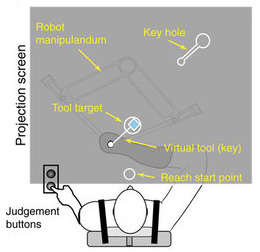Research Abstract
道具を用いた運動計画を決定する道具の即時的身体化
Immediate tool incorporation processes determine human motor planning with tools
2014年7月31日 Nature Communications 5 : 4424 doi: 10.1038/ncomms5524

ヒトが道具を器用に扱う能力は、脳が道具を身体の一部として表象する能力(道具の身体化)に由来すると考えられている。道具使用に伴い、脳内の身体表象や身体近傍空間が拡張することが報告されてきたが、このような道具の身体化は、長期的な道具使用の後に初めて見られるもので、我々が新しい道具を即座に使いこなす能力を説明できない。今回、我々は新たな2つの実験を行い、長期的身体化とは時間スケールの異なる即時的身体化が存在し、それが次に道具をどのように動かすべきかを決定する要因になっていることを示す。興味深いことに、長期の道具使用後には以前よりも腕が長く知覚される一方で、一回の道具使用の直後には、道具の長さに応じて腕は直前よりも短く知覚されることが分かった。本研究の結果から、道具使用は、身体表象に二重の影響を及ぼすことが明らかになった。つまり、道具の即時的身体化は、新しい道具使用時の運動計画を決定づける一方、長期的身体化は、繰り返しの道具使用に伴うスキルの熟達に関連した感覚運動マップの変化の結果生じるものだと考えられる。
G. Ganesh1,2, 吉岡 利福3, 大須 理英子3 & 池上 剛1
- 情報通信研究機構 脳情報通信融合研究センター (CiNet)
- CNRS-AISTロボット工学連携研究体、フランス国立科学研究センター(CNRS)
- 国際電気通信基礎技術研究所(ATR)
Human dexterity with tools is believed to stem from our ability to incorporate and use tools as parts of our body. However tool incorporation, evident as extensions in our body representation and peri-personal space, has been observed predominantly after extended tool exposures and does not explain our immediate motor behaviours when we change tools. Here we utilize two novel experiments to elucidate the presence of additional immediate tool incorporation effects that determine motor planning with tools. Interestingly, tools were observed to immediately induce a trial-by-trial, tool length dependent shortening of the perceived limb lengths, opposite to observations of elongations after extended tool use. Our results thus exhibit that tools induce a dual effect on our body representation; an immediate shortening that critically affects motor planning with a new tool, and the slow elongation, probably a consequence of skill related changes in sensory-motor mappings with the repeated use of the tool.

